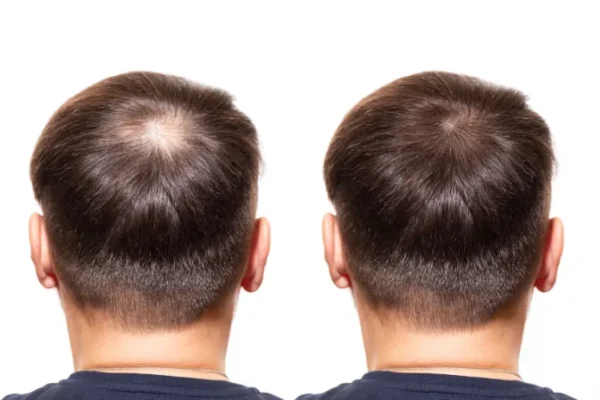Elite Hair Centers
We know that choosing a hair restoration provider is an important decision. At Elite Hair Centers, our unique dermatology and plastic surgery team is dedicated to delivering exceptional results with expertise and passion. This is what sets us apart from the competition.
Finasteride for Androgenetic Alopecia
Androgenetic alopecia (AGA) is primarily caused by the hormone dihydrotestosterone (DHT), which leads hair follicles to shrink and produce thinner, shorter hairs until they eventually stop producing hair. Finasteride, a common AGA treatment, blocks the conversion of testosterone to DHT by inhibiting the enzyme 5-alpha-reductase type 2. At a 1 mg/day dose, finasteride reduces serum and scalp DHT by 60-70%.
Originally approved by the US Food and Drug Administration (FDA) in 1992 for treating benign prostatic hyperplasia (BPH), finasteride was later found to be effective in treating AGA in men and now has an FDA indication for this purpose.
Several clinical trials have evaluated finasteride’s efficacy in treating AGA. In one randomized, placebo-controlled trial, 1553 men aged 18-41 with mild-to-moderate AGA were treated with either 1 mg/day of finasteride or a placebo for one to two years. Finasteride significantly increased hair growth and improved hair quality on the vertex scalp compared to the placebo. By month 24, two-thirds of finasteride patients were rated as improved (30% slightly improved, 36% moderately or greatly improved), while only 1% lost hair (compared to a third of placebo patients). However, despite over 80% of patients reporting slowed hair loss, only 50% of finasteride patients reported satisfaction with their hair overall (versus 25% in the placebo group), indicating that it is effective, but not often sufficient alone as a treatment for most men.
Studies have also demonstrated finasteride’s efficacy for frontal/anterior hair loss, although it seems less effective than in the vertex scalp. In another randomized, double-blind, placebo-controlled trial, 326 men with frontal male pattern hair loss were assigned to receive either finasteride 1 mg/day or a placebo for 24 weeks. Finasteride-treated patients (37%) showed a significant increase in frontal scalp hair count and significant improvements in patient, investigator, and global photographic assessments. Efficacy was maintained or improved throughout the second year of the study.
Finasteride also contributes to hair weight (determined by hair length and thickness), as shown in a randomized, placebo-controlled trial over four years. Patients treated with finasteride showed a 21.6% mean increase in hair weight from baseline, compared to a 24.5% mean decrease in placebo-treated men. Over the same period, the finasteride group experienced a 7.2% mean increase in hair count from baseline, compared to a 13% mean decrease in the placebo group.
Additionally, several meta-analyses have evaluated the overall efficacy of finasteride in treating AGA. One such analysis of 12 randomized controlled trials involving 3927 male patients found finasteride significantly increased hair growth and improved hair quality compared to the placebo.

summary
- Finasteride inhibits DHT production, halting AGA progression
- Clinical trials and meta-analyses support finasteride 1 mg/day as an effective AGA treatment, with the best results in preventing further hair loss (80-90% of men retain hair density, and 40% experience increased hair growth)
- Finasteride is more effective on the vertex scalp than the frontal region
- Effective only where hairs are still present (whether thin or thick); cannot grow hair in completely bald areas
- Takes 1-2 years to reach full effectiveness and can remain effective for several years
- Possible side effects include decreased libido and erectile dysfunction (typically affecting less than 3% of patients)
Dutasteride for Androgenetic Alopecia
Dutasteride is a potent medication that inhibits DHT production by blocking both types of the enzyme responsible for DHT production (5-alpha-reductase type 1 and type 2). This results in a mean serum reduction in DHT of 93-94%, with a half-life approximately ten times that of finasteride. While fewer clinical trials have evaluated dutasteride’s efficacy in treating AGA, the available evidence suggests it may be more effective than finasteride. Dutasteride is used off-label for AGA treatment.
In a randomized, controlled trial involving 153 men aged 18-49 with AGA, participants were given either 0.5 mg/day of dutasteride or a placebo for six months. After six months, 61.6% of dutasteride-treated men were rated by investigators as having improved vertex scalp hair growth, compared to 20% in the placebo group. Patient self-assessments also favored dutasteride, with 71% reporting improvement versus 36% in the placebo group. The most common adverse effect was sexual dysfunction, experienced by 4% of dutasteride participants and 3% of the control group.
Another study involving 917 men aged 20 to 50 with AGA randomized participants to receive dutasteride (0.02, 0.1, or 0.5 mg/day), finasteride (1 mg/day), or a placebo for 24 weeks. Hair count and width increased dose-dependently with dutasteride, and 0.5 mg/day dutasteride proved superior to both 1 mg/day finasteride and the placebo. Side effects were similar across all groups.
Higher doses of dutasteride (up to 2.5 mg/day) are even more effective, but they come with a significant increase in reported side effects. Consequently, 0.5 mg/day is typically used due to the higher side effect profile at larger doses.

summary
- Dutasteride is a more potent DHT inhibitor than finasteride
- Dutasteride at 0.5 mg/day is an effective AGA treatment, equivalent to or better than finasteride 1 mg/day, but is used off-label for this purpose
- Effective for over 90% of patients, with at least 50% noticing improved hair density and the other 50% maintaining their current density for an extended period
- Dutasteride is more effective for frontal hair loss than finasteride but works best on the vertex scalp
- Effective only where hairs are still present (whether thin or thick); cannot grow hair in completely bald areas
- Takes 1-2 years to reach full effectiveness and can remain effective for several years
- Side effect profile is similar to finasteride, though some patients may experience increased side effects or longer-lasting effects due to the longer half-life
FAQS
How do finasteride and dutasteride work for hair loss?
Finasteride and dutasteride are oral medications that work by inhibiting the enzyme 5-alpha-reductase, which converts testosterone into dihydrotestosterone (DHT). By reducing DHT levels, these medications help to slow down hair thinning and promote hair regrowth in cases of male pattern baldness. For this reason, they are very specific to the mechanism of androgenetic alopecia.
What is the difference between finasteride and dutasteride?
The main difference between finasteride and dutasteride is their potency and mechanism of action. Dutasteride inhibits both Type I and Type II 5-alpha-reductase enzymes, while finasteride primarily inhibits Type II. As a result, dutasteride is more effective at reducing DHT levels but may also have a higher risk of side effects. Finasteride is FDA approved for hair loss, whereas dutasteride is used off-label.
Who is a suitable candidate for these treatments and do they work?
Finasteride and dutasteride are primarily used in men with male pattern hair loss and are highly effective for greater than 90% of patients. They are generally not recommended for use in pre-menopausal women, particularly those who are pregnant or planning to become pregnant, due to the potential risk to a developing fetus; however, they are effective for many post-menopausal women who experience hair loss. It is important to consult to determine if you are a candidate for this treatment.
What are the potential side effects?
Common side effects of finasteride and dutasteride may include decreased libido, erectile dysfunction, and changes in ejaculation. These side effects are generally rare (less than 3%) and reversible upon lowering the dose or discontinuation of the medication. However, dutasteride may carry a slightly higher risk of side effects compared to finasteride.
How long does it take to see results?
Hair regrowth/thickening results from can vary among individuals. Some individuals may start to see improvement in hair growth and thickness within a few months, while others may require more extended periods, typically around six to twelve months, to observe noticeable changes. Consistency in medication use is crucial for optimal results.
What if I stop taking the medication?
Unfortunately, all the the hair that was preserved by the medication will be lost over 4-6 months after stopping it. Essentially, you will return to your normal state without the medication, but you will not lose additional hair because you were on the medication. Therefore, you should start the medication as soon as you can and be as compliant as possible.
Can finasteride or dutasteride be used in combination with other hair loss treatments?
Yes, they can be used in combination with other hair loss treatments, such as topical minoxidil, PRP, low-level laser therapy, and in concert with hair transplantation to potentially enhance the outcomes. Combining therapies may provide synergistic effects and address hair loss from different angles.
Is a prescription required for finasteride or dutasteride?
Yes, both finasteride and dutasteride are prescription medications and should be obtained under the supervision of a healthcare professional. It is important to consult with us to assess your suitability for the medication, provide guidance on proper usage, and monitor for any potential side effects or interactions.
TESTIMONIALS
REFERENCES
Kaufman KD, Olsen EA, Whiting D, Savin R, DeVillez R, Bergfeld W, Price VH, Van Neste D, Roberts JL, Hordinsky M, Shapiro J, Binkowitz B, Gormley GJ. Finasteride in the treatment of men with androgenetic alopecia. Finasteride Male Pattern Hair Loss Study Group. J Am Acad Dermatol. 1998 Oct;39(4 Pt 1):578-89. doi: 10.1016/s0190-9622(98)70007-6. PMID: 9777765.
Leyden J, Dunlap F, Miller B, Winters P, Lebwohl M, Hecker D, Kraus S, Baldwin H, Shalita A, Draelos Z, Markou M, Thiboutot D, Rapaport M, Kang S, Kelly T, Pariser D, Webster G, Hordinsky M, Rietschel R, Katz HI, Terranella L, Best S, Round E, Waldstreicher J. Finasteride in the treatment of men with frontal male pattern hair loss. J Am Acad Dermatol. 1999 Jun;40(6 Pt 1):930-7. doi: 10.1016/s0190-9622(99)70081-2. PMID: 10365924.
Price VH, Menefee E, Sanchez M, Kaufman KD. Changes in hair weight in men with androgenetic alopecia after treatment with finasteride (1 mg daily): three- and 4-year results. J Am Acad Dermatol. 2006 Jul;55(1):71-4. doi: 10.1016/j.jaad.2005.07.001. Epub 2006 May 3. PMID: 16781295.
Mella JM, Perret MC, Manzotti M, Catalano HN, Guyatt G. Efficacy and safety of finasteride therapy for androgenetic alopecia: a systematic review. Arch Dermatol. 2010 Oct;146(10):1141-50. doi: 10.1001/archdermatol.2010.256. PMID: 20956649.
Eun HC, Kwon OS, Yeon JH, Shin HS, Kim BY, Ro BI, Cho HK, Sim WY, Lew BL, Lee WS, Park HY, Hong SP, Ji JH. Efficacy, safety, and tolerability of dutasteride 0.5 mg once daily in male patients with male pattern hair loss: a randomized, double-blind, placebo-controlled, phase III study. J Am Acad Dermatol. 2010 Aug;63(2):252-8. doi: 10.1016/j.jaad.2009.09.018. Epub 2010 Jun 3. PMID: 20605255.
Gubelin Harcha W, Barboza Martínez J, Tsai TF, Katsuoka K, Kawashima M, Tsuboi R, Barnes A, Ferron-Brady G, Chetty D. A randomized, active- and placebo-controlled study of the efficacy and safety of different doses of dutasteride versus placebo and finasteride in the treatment of male subjects with androgenetic alopecia. J Am Acad Dermatol. 2014 Mar;70(3):489-498.e3. doi: 10.1016/j.jaad.2013.10.049. Epub 2014 Jan 9. PMID: 24411083.
Olsen EA, Hordinsky M, Whiting D, Stough D, Hobbs S, Ellis ML, Wilson T, Rittmaster RS; Dutasteride Alopecia Research Team. The importance of dual 5alpha-reductase inhibition in the treatment of male pattern hair loss: results of a randomized placebo-controlled study of dutasteride versus finasteride. J Am Acad Dermatol. 2006 Dec;55(6):1014-23. doi: 10.1016/j.jaad.2006.05.007. PMID: 17110217.

Before & After Gallery
*Individual results may vary.

